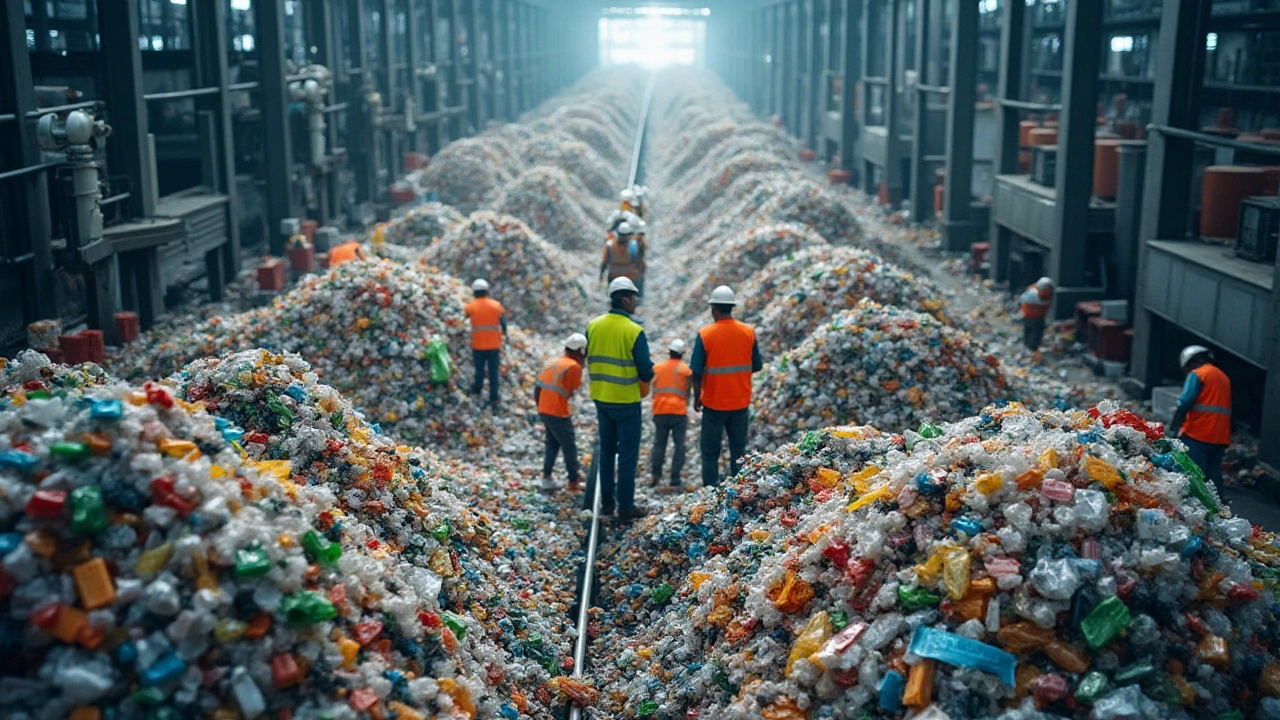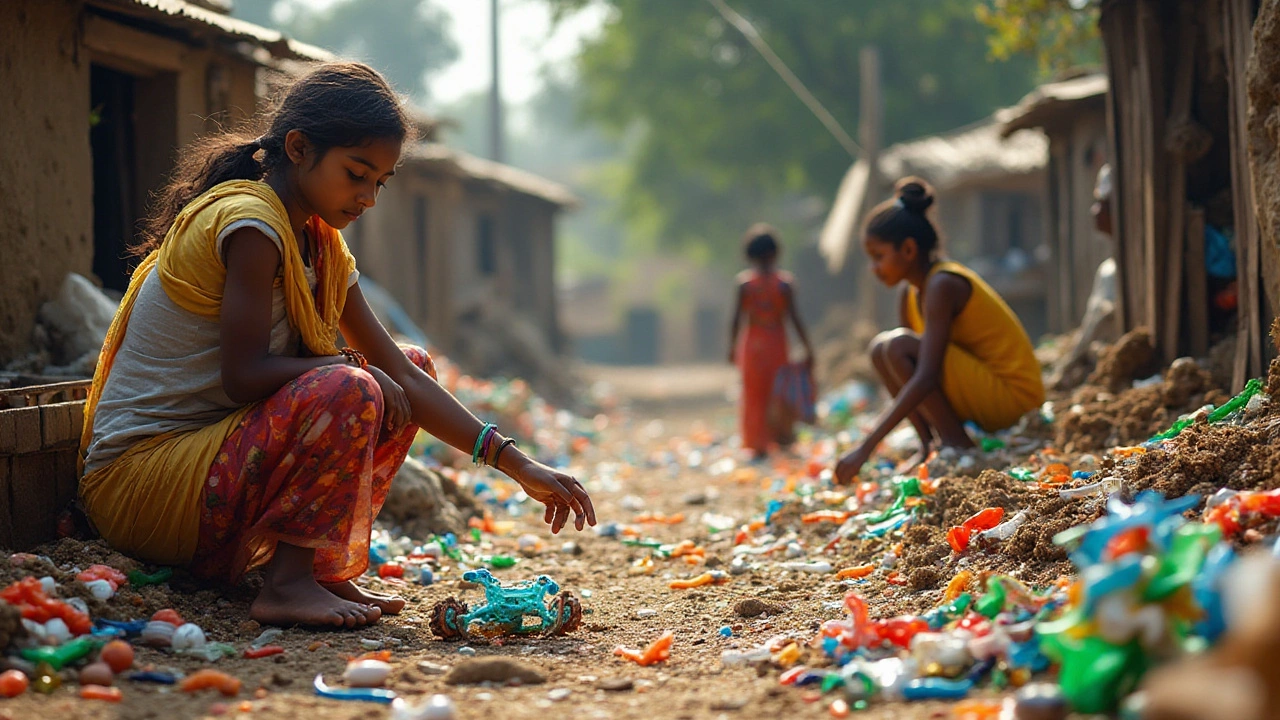Plastic waste is one of the most pressing environmental challenges we face today. It's scattered from the deepest oceans to the highest mountains, affecting wildlife and human health. With the convenience plastic offers, many overlook the grim aftermath of its disposal. The problem, however, is not just about the physical waste but the companies behind its production.
In this article, let's explore which companies lead the pack in creating plastic waste and how their operations impact our planet. The discussion also sheds light on the ecosystem's health, showcasing the imperative to take informed steps toward plastic reduction.
Understanding these dynamics is vital for any long-term solutions aimed at sustaining Earth's natural balance. By recognizing the top contributors, we can better grasp the roles these entities play and perhaps, steer them towards more sustainable practices. Join this revealing journey to uncover pressing facts and potential solutions.
- Overview of Plastic Waste Problem
- Leading Plastic Waste Producers
- Environmental and Health Impacts
- Steps Toward Reducing Plastic Waste
Overview of Plastic Waste Problem
Plastic waste is a pervasive issue that has ballooned into a significant global environmental crisis. The sheer volume of plastic produced and discarded is staggering. Estimates suggest that since the mid-20th century, over eight billion tons of plastic have been produced worldwide. A significant portion of this plastic ends up as waste, accumulating in landfills, oceans, and natural landscapes, causing immense harm to ecosystems. This enormous figure paints a grim picture of just how dominant plastic has become in modern life. Notably, single-use plastics account for a large part of this waste. Items like plastic bags, bottles, and straws are used once and discarded, yet they persist in the environment for hundreds of years.
The impact of plastic production and disposal reaches beyond just pollution. It affects wildlife substantially, as many animals mistake plastic for food, leading to severe injuries or death. Additionally, plastics do not biodegrade but instead break down into microplastics. These tiny particles infiltrate food chains, ultimately reaching humans, with uncertain health implications. The ramifications are concerning, and the need for effective pollution control strategies is urgent. According to a report by the World Wildlife Fund, nearly every marine species, ranging from plankton to whales, is now contaminated with plastic waste, highlighting the scale of the problem.
"Plastic pollution is not just an environmental problem; it's a health crisis," states John Hocevar, a marine biologist with Greenpeace International.
There's a socioeconomic angle to the problem as well. Developing countries often become the final destination for the West's plastic waste, exacerbating health and environmental issues in those regions. This dynamic creates a cycle where the wealthier countries offload their waste burdens, leaving the less equipped to bear the consequences. It's a complex web of production, consumption, and disposal that calls for a comprehensive approach to management and prevention. Government policies, consumer awareness, and corporate responsibility all play pivotal roles in tackling this issue. Efforts are being made to reduce plastic usage, promote recycling, and develop biodegradable alternatives, but these need to be significantly ramped up to meet the scale of the challenge. The global community must unite to curtail plastic waste at its source, ensuring a sustainable future.
As awareness grows, so does the responsibility on large plastic manufacturing and consumption companies to innovate and lead in waste reduction. There's a growing consensus that while recycling remains a piece of the puzzle, the primary focus should be on reducing production altogether and developing alternative materials that pose less risk to the environment. This shift requires not only technological advancements but also a cultural change in how we view and use plastics. It's a monumental task but not insurmountable with collective effort and strategic initiatives.

Leading Plastic Waste Producers
When we scrutinize the giants of plastic manufacturing, several names in the industry repeatedly surface. These conglomerates are at the heart of the plastic waste dilemma, producing massive amounts that eventually find their way into our ecosystems. Among these producers, ExxonMobil, Dow, and Sinopec have been identified as leading contributors to plastic pollution. Their influence extends beyond their primary businesses, deeply intertwining with our environmental health.
ExxonMobil, one of the largest publicly traded energy companies, is also a major player in the production of virgin polymer, a key ingredient in plastic products. According to the Minderoo Foundation's Plastic Waste Makers Index, ExxonMobil tops the list as a major plastic polluter. The reliance on single-use plastics and bulk packaging contributes significantly to the waste numbers. Insider reports indicate that ExxonMobil's plastic production alone accounts for significant shares of the global output, creating a large footprint of persistent waste that accumulates in landfills and oceans. Meanwhile, Sinopec, a Chinese state-owned oil and gas enterprise, stands second in plastic production. China's rapid industrial growth in recent decades has skyrocketed its demand and supply chain for polymers and plastics. Sinopec's strategic expansion into petrochemicals has been both lauded for economic growth and criticized for its environmental impacts. These expansions not only fuel consumption but also lead to large-scale waste generation that is difficult to manage without effective recycling systems.
As for Dow Inc., the company's innovative chemical solutions have positioned it as a leader in industrial goods. Unfortunately, with great scale comes great responsibility. Dow's polymer production aligns closely with global industrial growth, yet it also marks them as a contributor to plastic debris. Their focus on sustainable solutions and recycling is commendable, yet the scale of production still overshadows these initiatives. A deeper commitment to controlling emissions and fostering a circular economy could potentially mitigate their environmental footprint. In a recent environmental report by an independent research group, it was stated,
"The big players like ExxonMobil, Sinopec, and Dow are certainly doing more than before to shoulder their share of environmental responsibility, but tangible results are yet to be widely felt."
The conversation doesn't stop with naming these companies; it extends to discussing actionable solutions and their implementation. The integration of advanced recycling technologies and a shift in corporate strategies towards biodegradability are necessary steps. Governments and NGOs also play a crucial role in bringing awareness and enforcing regulations to curb excessive waste production by these giants. Thus, fostering a collaborative environment that encourages less reliance on single-use plastics and promotes innovative substitutes can pave the way forward.

Environmental and Health Impacts
Plastic waste has an insidious way of infiltrating ecosystems, posing a grim threat to both the environment and public health. The journey of plastic begins when it is manufactured by leading plastic manufacturing companies, but it certainly does not end there. Instead, it meanders through landfills and oceans, where it can endure for centuries. Microplastics, tiny fragments of plastic, are particularly problematic. They slip through waste management systems and infiltrate water bodies, eventually making their way back into the food chain. These microplastics have been found in marine organisms and even in salt and honey, according to recent studies.
The environmental impact of plastic begins with its creation. Derived mostly from non-renewable fossil fuels, the production of plastic leads to significant carbon emissions, contributing to air pollution and the broader issue of climate change. The degradation of plastic waste, on the other hand, results in the release of toxins such as bisphenol A (BPA) and phthalates, which are linked to adverse effects on wildlife and the reproduction systems of various species. Animals, particularly marine creatures, become entangled in plastic debris or mistakenly ingest it as food. This can lead to injury, illness, or tragically, death.
From a human health perspective, the stakes are just as high. The chemicals leached from plastics have been associated with hormonal disruptions, which can cause reproductive issues and developmental problems in children. According to a report by the World Health Organization, there is growing concern about the health consequences associated with the ingestion of microplastics, which have been detected in drinking water. They call for a "drastic reduction in plastic pollution" to safeguard public health. This troubling scenario demands a collective reassessment of our relationship with plastic—an entity we have long revered for its convenience.
In recent years, awareness about the environmental and health implications of plastic waste has grown. Activists and organizations worldwide are pushing for stricter regulations on plastic production and the development of biodegradable alternatives. Some countries have introduced bans on single-use plastics, while others advocate for increased recycling efforts. Yet, the responsibility also lies with individuals to make informed choices about their plastic consumption and disposal habits. Initiating small lifestyle changes, like using reusable shopping bags, can gather momentum into significant societal shifts that mitigate the adverse impacts of plastic waste.
Plastic Pollution in Numbers
Grasping the full extent of plastic's environmental footprint requires examining relevant statistics. Data reveals staggering figures: approximately 300 million tons of plastic are produced yearly worldwide, with the United States being the largest plastic waste producer. Alarmingly, less than 10% of this plastic is recycled, according to National Geographic. The remainder accumulates in landfills, oceans, and natural landscapes. An estimated 8 million tons of plastic end up in oceans each year, equivalent to a garbage truck full of plastic every minute.
To conclude, this pervasive and persistent issue calls for robust solutions from both industry leaders and individuals. The path forward involves embracing sustainable practices, demanding accountability from industries, and fostering a global commitment to significantly reduce plastic waste. As Margaret Mead famously said, "Never doubt that a small group of thoughtful, committed citizens can change the world; indeed, it's the only thing that ever has." Such words remind us of the impact each person can have, a valuable insight in the pressing fight against plastic pollution.

Steps Toward Reducing Plastic Waste
Taking action against plastic waste involves not just one entity but a collaborative effort spanning industries, governments, and individuals. The first critical step is reducing our reliance on single-use plastics. Items like plastic bags, straws, and bottles are notorious for their short life span and long-lasting environmental impact. Encouraging the adoption of reusable alternatives can significantly curb this habit. Engaging local manufacturers and retailers in promoting reusable products through incentives or regulations can be highly effective in this regard. Not only does this reduce waste, but it also inspires consumer awareness and responsibility.
Recycling plays a crucial role in managing existing plastic materials. However, recycling rates are often below optimal due to inadequate facilities or public apathy. Improving recycling technologies and infrastructure is vital, as is educating people on correctly sorting recyclable materials. Governments can aid this process through policy changes that mandate manufacturers to take responsibility for their plastic products post-consumer use. This can create a circular economy where materials are continuously reused, reducing the need for raw plastic production.
The innovation of biodegradable plastics is an exciting development in the quest to minimize plastic waste. While still under development, these materials offer the potential to break down more naturally and reduce long-term pollution. Continued research and investment in this technology could lead to more widespread usage and acceptance. As such products gain popularity, the demand for traditional plastics may diminish, fostering a more sustainable production cycle.
Governmental and Corporate Responsibility
Governments and major corporations hold significant power in driving change. Policies and regulations that control or limit plastic manufacturing can push industries towards more sustainable practices. For instance, setting high tariffs on non-recyclable plastics or offering tax breaks for sustainable innovations can be effective strategies. Companies like Coca-Cola and Nestlé have opted to make bold commitments towards reducing their plastic usage and investing in recycling programs. It’s important to ensure these commitments are enforceable and result in tangible outcomes."Plastic pollution has presented long-lasting implications to ecosystems." — National GeographicThis statement underpins the urgent need for a unified response to tackle the issue. Therefore, lobbying for stricter global regulations on plastic production and waste management becomes imperative. Compliance and international cooperation can collectively bridge gaps that national policies alone cannot address.
Ultimately, through a combination of policy reform, technological innovation, and individual initiatives, substantial progress can be achieved in reducing plastic waste. Each small change contributes to a larger, more impactful movement, paving the way towards a cleaner, healthier planet.

